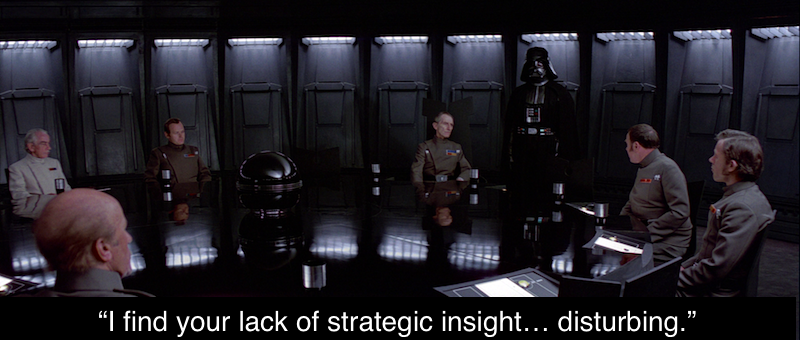It’s annual review time once again, that precious time of year when every manager gets to say to his underlings, “Remember when you really annoyed me last February? I do!” It’s a time for cheers, tears, and annoyed grunts. Much like Christmas or our wedding day, we enter with big expectations and some of us get lucky, while others end up with cake all over our faces, wondering who all these strangers are and who stole our pants. Maybe that’s just me. Either way, that was one strange review process and I’m glad I only worked there for four years.
Anyway, performance reviews can be extremely valuable if done correctly (and with minimal de-pantsings). They offer an opportunity to step aside from the day-to-day, reflect on how other people are doing their jobs, and then tell them what you think of them. Constructively, of course (or not, if you want them to quit). This process is called “feedback,” and like the screeching sound created by holding an electric guitar too close to a speaker, it’s an acquired taste that can make you look like a genius if you do it correctly. And I want nothing more than to make you look like a genius, especially if you work for me, because then I can take credit for hiring you. Reading this article counts as mentoring, by the way. Without further ado, here are 5 tips for giving the kinds of performance reviews that will have people asking for them every quarter!
1. No surprises
If you spent an entire year working side-by-side with people and none of them ever gave a hint as to how they feel about you and your work, you should check to see if you are invisible or someone’s imaginary friend.
I open every performance conversation with the phrase, “None of this should come as news to you….” This is because, if I’ve waited for a whole year to tell someone what they’re doing well or poorly, then they really shouldn’t have stuck around. We all want to hear praise when we do something well, and people who say, “The work is its own reward” are either liars or living in complete solitude. If you spent an entire year working side-by-side with people and none of them ever gave a hint as to how they feel about you and your work, you should check to see if you are invisible or someone’s imaginary friend. As a manager, you owe it to your people to say, “Good job,” “Thank you,” and “Wow, I never would have thought of that,” especially when it’s true. I’m not talking about fawning over people and telling every one of them what a special, special flower they are. That’s up to their parents. But if they do something well and you want to ever see them do it again, you need to tell them.
If, on the other hand, someone does something that you don’t want them to do, you need to correct them so they don’t keep doing it. I’ve seen managers wait an entire year before telling someone that they had been making obvious mistakes that irritated everyone around them, mainly because the manager wouldn’t have an uncomfortable conversation until they were forced to. By that point, the damage was done and the person was left saying, “Why didn’t you tell me that I was doing that? Everyone hates me now!” That sort of surprise leaves you feeling like you’ve just come home from a cocktail party, only to have your wife tell you that you had a huge piece of spinach in your teeth for the entire night and excuse herself by saying, “I didn’t want to embarrass you.” Man up (or woman up, if you prefer) and have the uncomfortable conversation immediately, so that, at review time, you can say, “I know you’re working on this, and you’re already improving.”
2. Be specific
If you feel like your people are wandering around making terrible decisions, maybe you need to look at the guidance you’re providing.
I once dated a girl who told me, “I need you to make me feel special. And you need to be more attentive.” I had no idea what to do with that guidance. Was I supposed to praise her constantly? Buy her gifts that I couldn’t afford? Stare at her for hours on end? How was I supposed to make her feel anything? Maybe I was supposed to slip Xanax into her drink. Would that make her feel special, or just sleepy? I couldn’t handle the confusion, so I broke up with her. (I feel compelled at this point to state that this was not my wife, because she’s awesome and would never say crazy things like this. Hi, honey!)
Sometimes, while trying to be helpful, we can sound like crazy work girlfriends: “You need to be more motivated!” “I need to see that you really care about your career here at Acme Corp.!” “The client feels that you aren’t really looking out for them. Go fix that. But don’t give anything away for free! Oh, and make them feel special!” General guidance leads to general behavior (also known as “erratic,” “hit-and-miss,” or “spotty improvement”). If you feel like your people are wandering around making terrible decisions, maybe you need to look at the guidance you’re providing. Are you giving them a specific target to hit, or are you just pointing them in the general direction of “better?” Can you remember the last time you pointed out a specific example of something they did well or something that they shouldn’t have done? Human brains can handle abstract concepts, but we’re still wired for narrative. If you can tell me a story with a happy ending, then I can generalize it to bring about other happy endings. If you illustrate my own personal office tragedy for me, then you can help me rewrite it in my head so that the ending is better next time. If you just tell me to be happy, then eventually I’m going to have to break up with you and find someone who can show me how that’s done.
3. You aren’t a mind reader
When you give in to that desire to know why people do things, instead of focusing on what they did, then you brand them in your mind, for good or ill.
Speaking of narrative, we all love to tell ourselves stories about the people around us, and every good story needs motivation and characterization. Jack sold the cow for a handful of beans because he was foolish and a dreamer, but he stole the giant’s treasure because he wanted adventure and he loved his mother very much. He killed the giant because, underneath the foolishness, he was also very clever. This works well when you’re writing fiction, but it can be disastrous when you’re dealing with real people. You can assume that Jack screwed up the budget because he’s lazy and doesn’t pay attention to detail, but what if he’s actually very conscientious and Jill gave him the wrong information? You’ve already decided that Jack is lazy and stupid, so you aren’t going to trust him with important tasks anymore. He gets bored with simple activities, which only reinforces your image, so eventually you fire him. Then he goes on to become the CFO of your competitor, Giant Industries, and crushes you (see what I did there?).
We all want to understand other people’s motivations, especially when they do something we don’t like. We want to know why they did that annoying, hurtful, or dumb thing so that we can make them never do it again. The problem is, unless you ask the person why they’re acting a certain way, you’ll never know for sure. In fact, you really can’t know for sure even if you ask them, because sometimes people lie. And sometimes they don’t even know. And the problem with these assumptions, especially assumptions about a person’s character or capabilities, is that they’re permanent. Jack can’t stop being stupid even if he wants to.
When you give in to that desire to know why people do things, instead of focusing on what they did, then you brand them in your mind, for good or ill. Now, that’s not to say that some people aren’t stupid, careless, or lazy. There are plenty of those people around, and their consistent behavior will show it over time. It just doesn’t do you any good to make that decision for them, because what are you going to do: tell them to stop being lazy? If that was your answer, please reread Tip #2, above. Whatever a person’s inherent character traits or innate capabilities are, they’re beyond your reach. All you can monitor, quantify, or change is their behavior, so that needs to be your focus. Which bring us to…
4. Behavior leads motive
When striving for better performance, the wise manager focuses on behavior first and motive second.
What is performance but behavior over time? Good performance, bad performance, high performance or low, it’s nothing but the sum of our daily activities gathered up into an annual bundle. Do you really need to know that I nailed that client presentation because I want to have your job within three years? Or that I finished that project early because I wanted to take a long weekend? Or that I was late to the big meeting with the Sea World account because I have a crippling, inexplicable fear of dolphins? You don’t really need to know what my motives are as long as you’re getting the behavior that you need. But most of us want to do the right things for the right reasons, and we want the same from the people around us.
So how do we get there? For years, consultants, pastors, life coaches, and motivational speakers have tried to change behavior from the inside out. By changing people’s motives, we hoped to change their behaviors. Motivate the employees and they’ll work harder. Teach the fat people to want to be skinny and they’ll change their eating habits. Tell the criminals that crime is bad and they’ll stop doing it. We thought it would be easier, because once you changed the one thing (motive), then all the other things (behaviors and actions) would naturally follow. One is less than a bunch, so the math seemed easy. There are three problems with this:
- Internal motives are closely held, often core to a person’s self-image, and really hard to change.
- Even with the right motives, people often still do the wrong things.
- Even good motives can conflict and cancel each other out.
I want to lose 25 pounds. I am motivated to do so by all of the pictures on the health magazines that show me what my ripped abs look like, if I can just find them under that layer of extra insulation. I know that I will be healthier if I lose 25 pounds and that being healthier is better. All of my motives are correct. And yet, the 25 pounds remain (year after freaking year). So am I poorly motivated, or am I embracing the wrong behaviors?
Did I mention that I also enjoy food? This is also a good motive, but it conflicts with my desire to lose weight. Given the choice between not eating something delicious and eating it, I will generally choose to follow the motive that puts something delicious in my mouth. I don’t overeat, binge, or try to eat my feelings, so this isn’t an unhealthy motivation, but it’s keeping that 25 pounds hanging around (did I mention year after freaking year?).
In Outliers, Malcolm Gladwell points out that it isn’t the most motivated (or even talented) players who succeed in professional sports. It’s those who work the hardest, those who have the right behaviors. Whether they’re doing it because they love their Mama and want to buy her a house or because they hate A-Rod (and who doesn’t?) and want to beat him until he cries like a little girl, it’s the actions that they take in response to those motivations that make them successful. In the same way, when striving for better performance, the wise manager focuses on behavior first and motive second. If you tell your people what you want them to do — and make it specific enough for them to take action — then you have a much higher chance of success than if you try to make them feel better about their jobs.
The interesting thing about this is, when the behavior is better, then the job satisfaction and the motivation tend to follow. When I do something well, I’m happy about it, which makes me want to do it more, which makes me better at it. When I do something poorly or I receive negative feedback, I don’t like that feeling, so I don’t want to do that thing again. Proper feedback and guidance on behavior, then, leads to better outcomes, which lead to better motivation. I may still be doing well because I want your job, but if I and my teammates are all doing a great job, then you’re likely to get promoted, so you won’t need that old job anyway. Everyone wins.
5. Don’t forget to dream
Get through the boring stuff... and take advantage of this annual break in the action to think about what might come next.
Let’s face it: unless you enjoy making people uncomfortable or you’re one of those people who offers “constructive criticism” to the wait staff, performance reviews kind of suck. And if you’re following these tips, especially #1, they can start to feel unnecessary as well. So if you’re like me and you can start your reviews with, “This shouldn’t be news to you…” then use this opportunity to dream a little. Get through the boring stuff — “You’re awesome, I helped make you that way, and you’re already improving on that little thing we talked about last week” — and take advantage of this annual break in the action to think about what might come next. What are your dreams for your team, as a group and as individuals? What could they do that would make you stand and proudly watch them like a dad whose kid just hit a home run? What will make them glad to come to work each day, what challenges make their eyes light up? How can you help them be so awesome that they don’t even need you anymore? What do they want to do next? Don’t know the answers? Here’s a thought: ask them. After all, it’s their performance review. Shouldn’t they get a chance to talk, too?
You’re doing a great job. Keep up the good work.


















